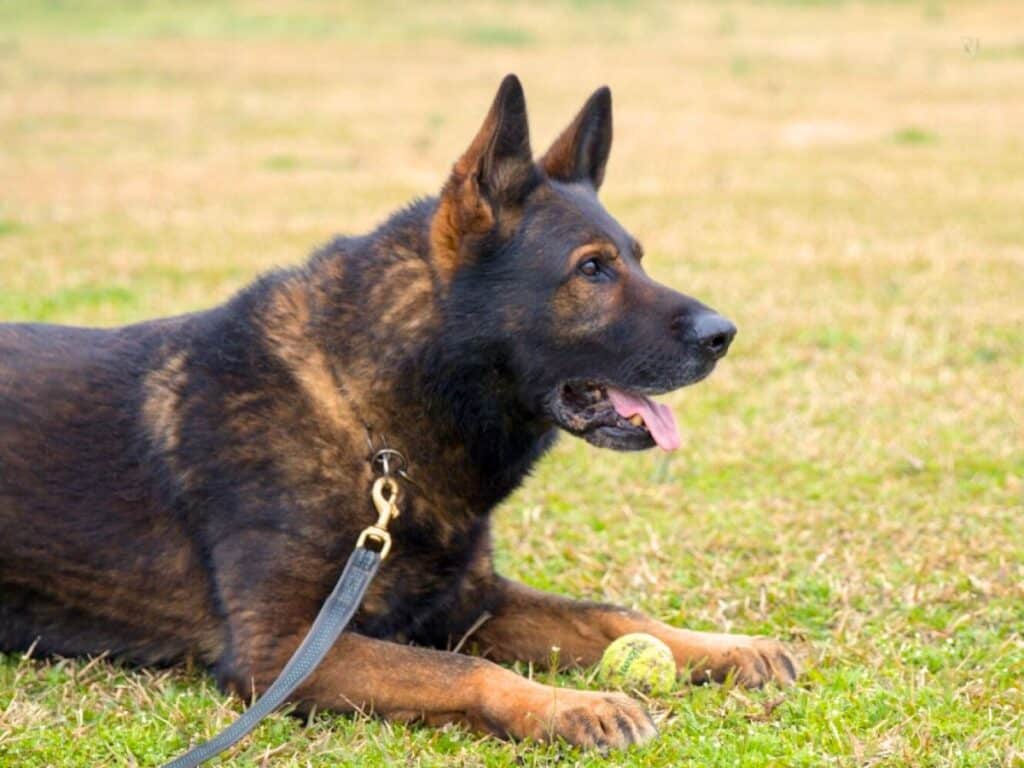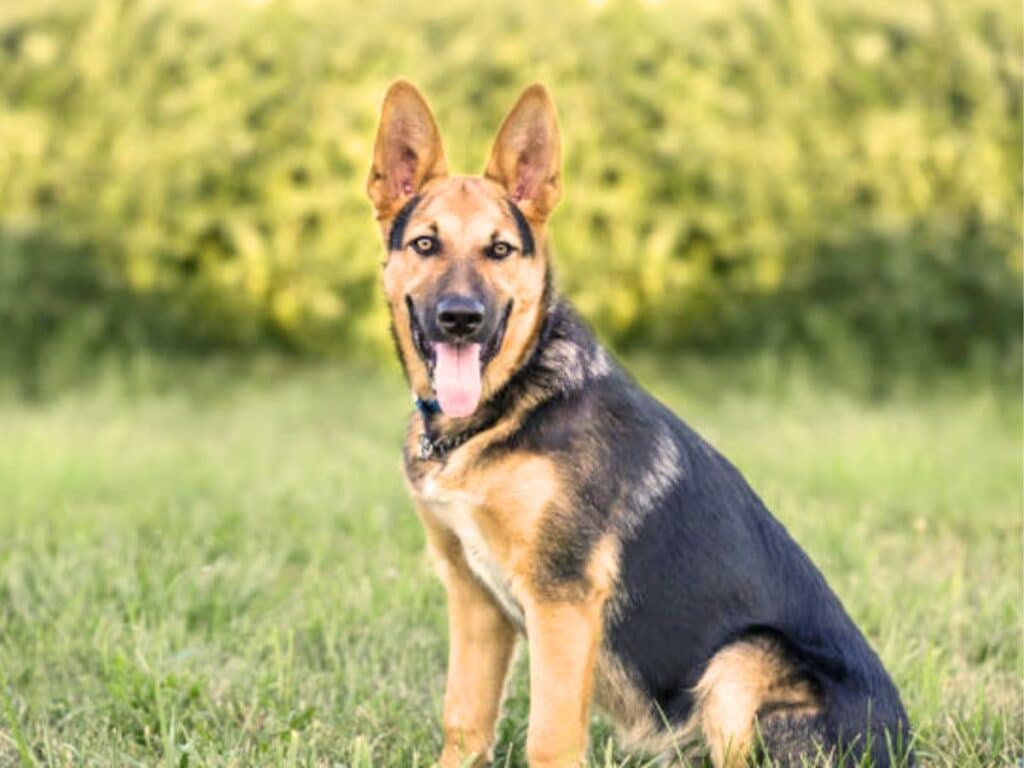A 5-month-old German Shepherd is an adorable and energetic pup that is starting to develop into a loyal and intelligent companion.
At this age, your doggy is in the midst of crucial developmental stages and requires proper care and training to ensure they grow up to be a well-behaved and healthy dog.
In this article, we’ll explore everything you need to know about raising and caring for your 20-week-old GSD pup.
From training tips to nutrition, we’ll cover the essentials to help you provide the best possible care for your young pup.
5 Month Old German Shepherd: A Closer Look
In the following table, we delve into the physical appearance, behavior, training milestones, and health care considerations of your 5-month-old German Shepherd to help you in providing the best care and companionship to your furry friend.
| Appearance | Well-proportioned body, erect ears, bushy tail |
| Height | 12 -16 inches, with males typically being taller than females. |
| Weight | 35 – 49 pounds, with males typically being heavier than females. |
| Coat | Double coat; dense with a medium-length topcoat. |
| Ears | May still be in the process of standing up, with one or both ears possibly floppy. |
| Energy Level | High energy levels, loves to play and explore |
| Exercise Needs | Requires 30 mins – 1 hour of regular exercise and mental stimulation |
| Socialization | Developing social skills; may be curious and friendly with people and other animals. |
| Training | Highly intelligent and trainable; should learn basic commands. |
| Behavior | Curious, May display some stubbornness or independence, typical teenage behavior. |
| Teething | Should have adult teeth but the teething stage may continue, with a strong urge to chew on objects. |
| Diet | Feeding 3-4 times a day with high-quality puppy food for large breed pups. |
| Healthcare | Regular veterinary check-ups and vaccinations are important. |
| Vaccinations | Should have had at least 3-4 shots of DHPP & other non-core vaccines. |
| Sleep | Sleeping around 14-16 hours a day, with periods of playfulness. |
| Toilet Training | Progressing in housetraining; may still have occasional accidents. |
| Playtime | Enjoys interactive play, fetch, and chewing on appropriate toys |
| Sexual maturity | Approaching sexual maturity, GSDs reach sexual maturity between 6 to 12 months of age |

5 Month Old German Shepherd Weight
A 5-month-old male German Shepherd usually weighs between 40-49 pounds while a female German shepherd can weigh around 35-42 pounds.
At 5 months old, your German Shepherd puppy is in the midst of a rapid growth phase. Their body undergoes a remarkable transformation as they gain both height and weight at an accelerated pace.
How Big Should a 5 Month Old German Shepherd Be?
The size of a 5-month-old German Shepherd can vary, but on average, male German Shepherds are typically between 12-18 inches tall while females can be between 11-16 inches in height.
However, it’s important to note that every dog is different and may not fit within these ranges. It’s also crucial to remember that at this age, German Shepherds are still growing rapidly and will continue to do so until around 18 months of age.
To learn more about your puppy’s height and weight at different stages of their life, please refer to my article: German Shepherd Growth & Weight Chart By Age

What Does a 5 Month Old German Shepherd Look Like?
At 5 months old, a German Shepherd puppy is still in the midst of its growth and development, transitioning from the early puppy stage to adolescence.
- Size: The puppy is growing rapidly, but it’s still considered a juvenile. At this age, you might observe that your puppy’s legs appear longer, giving them a slightly more adult-like appearance.
- Coat: German Shepherds have a double coat, and at 5 months, their fur is becoming denser. The coat may still be relatively short, but it will continue to grow and develop.
- Ears: At 5 months, some puppies will have fully erect ears, while others may still be in the process of standing up.
- Teeth: At five months, the puppy will likely have most of its adult teeth, although teething may still be ongoing. Chewing on appropriate toys can help with this process.
- Gait and Movement: German Shepherds are known for their smooth and powerful gait. By five months, a puppy will be more coordinated and exhibit a more adult-like movement, although they will continue to refine their skills as they grow.
Feeding Your 5 Month Old GSD
When it comes to feeding a 5 month old German Shepherd Dog, it is important to provide them with a balanced and nutritious diet to support their growth and development.
What to Feed a 5 Month Old German Shepherd?
A 5-month-old German Shepherd should be fed a premium brand of puppy food specifically formulated for large breed puppies.
Look for a product that contains high-quality protein sources, such as chicken or lamb, as well as essential nutrients like omega-3 fatty acids, DHA, and calcium.
Choose healthy and age-appropriate treats for your pup. Opt for treats made specifically for puppies and avoid those that are high in fat or contain artificial ingredients. Treats can be used for training purposes or as occasional rewards.
Make sure your puppy has access to fresh, clean water at all times. Hydration is crucial for their overall health and well-being.
RELATED: How Much Water Do German Shepherds Drink in a Day?
To know more about what German Shepherds can and can not eat, you can check out my article: What Do German Shepherds Eat?

How Much Should a 5 Month Old German Shepherd Eat?
As a general guideline, a 5-month-old German Shepherd should eat 3 – 4 cups of high-quality puppy food spread over 3 – 4 meals per day to prevent overeating and aid digestion.
As your German Shepherd grows, you can gradually reduce the number of meals to two per day.
The amount of food a puppy should eat can vary based on factors such as the specific brand of food, the puppy’s weight, activity level, and metabolism.
It’s crucial to follow the feeding guidelines provided by the manufacturer on the packaging of the puppy food you choose. These guidelines typically indicate the recommended daily amount based on the puppy’s weight.
RELATED: German Shepherd Feeding Chart By Age
How Many Calories for 5 Month Old German Shepherd?
As a general guideline, a 5-month-old German Shepherd puppy needs at least 2000 – 2200 calories per day.
The exact number of calories a 5-month-old German Shepherd needs can vary based on factors such as weight, activity level, metabolism, and the specific brand and type of dog food being fed.
Feeding Guidelines For Your Pup
- Ensure that the puppy food (for large breed puppies) has an appropriate balance of protein, fat, and carbohydrates. Protein is essential for muscle development, while fat provides energy.
- Look for puppy foods that contain essential vitamins and minerals like calcium and phosphorus for bone health.
- Avoid feeding your puppy human food, especially items that can be harmful, such as chocolate, onions, garlic, and certain artificial sweeteners.
- Follow the recommended feeding guidelines on the puppy food packaging based on your puppy’s weight and age.
- Be cautious not to overfeed, as rapid growth can contribute to skeletal issues in large breeds.
- Always provide access to fresh, clean water. Hydration is crucial for overall health and digestion.
- Regularly monitor your puppy’s weight and adjust the feeding amount accordingly.
RELATED: 6-Month-Old German Shepherd: What to Expect

Training Your Puppy
Training a 5-month-old German Shepherd involves a combination of basic obedience commands, socialization, and positive reinforcement. Here are some tips to help you train your German Shepherd puppy:
1. Start with Basic Commands
Begin with basic commands such as “sit,” “stay,” “come,” and “down.” These commands form the foundation of obedience training.
Use clear, consistent verbal cues and hand signals along with treats or rewards to reinforce desired behaviors.
Reward your puppy with treats or praise immediately to help your puppy make the connection between the action and the reward.
RELATED: German Sheperd Training For Beginners
2. Socialization
Expose your puppy to various environments, people, other dogs, and different stimuli to build confidence and reduce the likelihood of fear or aggression issues later on.
RELATED: How To Socialize Your German Shepherd Puppy
3. Leash Training
Teach your German Shepherd to walk nicely on a leash. Use treats and positive reinforcement to encourage loose leash walking.
Gradually increase the duration and complexity of walks, exposing your puppy to different environments and distractions.
RELATED: How To Leash Train Your GSD Puppy
4. Crate Training
Introduce your puppy to a crate early on to provide them with a safe and comfortable space. Use positive reinforcement to create positive associations with the crate.
Gradually increase the time your puppy spends in the crate, making it a positive experience.
RELATED: How To Crate Train A German Shepherd Puppy
5. Teach Basic Manners
Teach your puppy basic manners, such as not jumping on people, not biting or nipping, and waiting for permission before going through doors.
Consistency and positive reinforcement are crucial for establishing good manners.
RELATED: How To Discipline A German Shepherd Puppy
6. Enroll in Puppy Classes
Consider enrolling your German Shepherd in a puppy training class. These classes provide structured training and socialization opportunities under the guidance of a professional trainer.
Remember that each puppy is unique, and training progress may vary. Adjust your training approach based on your puppy’s temperament and needs.
Check out this video of a young 5 month old German Shepherd puppy undergoing training…

5 Month Old German Shepherd Behavior
At 5 months old, German Shepherds are still in their puppy stage but are starting to show signs of adolescence. Here are some common behaviors you may observe in your pup:
- Playfulness: German Shepherd puppies are generally energetic and playful. They may engage in lively play sessions with toys or other dogs.
- Exploration: Curiosity is a typical trait at this age. Your puppy may be eager to explore its surroundings, sniffing and investigating everything.
- Attention-Seeking Behavior: Your puppy may seek attention and companionship.
- Biting/Nipping: Puppies often explore the world with their mouths, and this may include mouthing or nipping. Use positive reinforcement to teach bite inhibition and discourage inappropriate mouthing.
- Independence: Your pup may test boundaries, become more stubborn, or try to assert dominance. Consistent training and establishing yourself as the pack leader will help curb any unwanted behaviors.
- Fear period: Some German Shepherds go through a fear period at around 5 months old. They may become more cautious or fearful of new things or situations. It’s important to handle these situations with patience and gradually expose them to their fears in a controlled and supportive manner.
If you encounter challenges or have specific concerns about your puppy’s behavior, consider enrolling in a puppy training class or seeking guidance from a professional dog trainer.
RELATED:

Exercising Your Puppy
German Shepherds are known for their high energy levels, intelligence, and athleticism. Providing appropriate exercise for your pup is essential for their physical and mental well-being.
It’s important to note that while exercise is essential, it should be age-appropriate to avoid putting excessive strain on your puppy’s developing joints and bones.
Here are some guidelines for exercising your puppy at this age:
- Playtime: Engage in interactive play sessions with your puppy. Games like fetch, tug-of-war, and chase can provide both physical exercise and mental stimulation.
- Structured Walks: Start incorporating short, structured walks into your puppy’s routine. Begin with shorter distances and gradually increase the duration as your puppy’s stamina improves.
- Off-Leash Play: If you have a safe and secure area, allow your puppy some off-leash playtime. This provides them with the freedom to explore and burn off excess energy.
- Chew Toys and Puzzle Feeders: Provide your puppy with appropriate chew toys and puzzle feeders. Chewing helps with teething, and puzzle feeders engage their minds as they work to retrieve treats.
- Agility Exercises: Set up simple agility courses using cones, tunnels, or low jumps.
- Swimming: If your puppy enjoys water, consider introducing them to swimming.
- Rotate Activities: Vary the types of exercises to keep your puppy mentally stimulated.
RELATED: How Much Exercise Does a German Shepherd Need Daily?
How Far Can a 5 Month Old German Shepherd Walk?
As a general guideline, a 5-month-old German Shepherd puppy can walk for 15 – 20 minutes once or twice a day.
Gradually increase the length of the walks as your puppy grows and develops more stamina. Pay attention to your puppy’s behavior during and after walks, and adjust the duration accordingly.
It’s crucial to avoid overexertion and high-impact activities, such as running on hard surfaces or jumping from heights, as these can potentially harm the developing joints of a young puppy.

FAQs
Can a 5 Month Old German Shepherd Get Pregnant?
No, a 5-month-old German Shepherd is not physiologically mature enough to become pregnant. Female dogs typically reach sexual maturity and come into their first heat cycle, known as estrus, between six months and one year of age, with variations based on individual dogs and breeds.
To learn more about this topic, please refer to my articles:
- German Shepherd Heat Cycle: Length, Frequency, & Stages
- Neuter or Spay Your German Shepherd: Timing, Pros & Cons
5 Month Old German Shepherd Ears Not Up
In many puppies, the ears start to stand up between 4 to 6 months of age. However, the timing can vary from dog to dog, and some German Shepherd puppies may take longer for their ears to fully stand.
If your 5-month-old German Shepherd’s ears have not yet stood up, here are a few tips to help encourage ear development:
- Massage the Ears: Gently massage your puppy’s ears to help stimulate blood flow and encourage the muscles and cartilage to develop properly.
- Provide Proper Nutrition: Ensure your puppy is receiving a balanced diet suitable for their age and breed. Adequate nutrition supports overall health, including ear development.
- Consult Your Veterinarian: If you have concerns about your puppy’s ears, or if they don’t seem to be standing up as expected, consult with your veterinarian.
It’s important to note that the process of ears standing up can continue for several months, and each puppy is unique.
To learn more about German Shepherd’s ear stages & development, please check out my following articles:
- When Do German Shepherd Ears Stand Up?
- German Shepherd Puppy Ear Stages
- Floppy Eared German Shepherd: Why & How To Fix It
Summary
In conclusion, caring for a 5-month-old German Shepherd involves a balanced approach to training, exercise, and nutrition. Understanding and addressing their developmental needs, including socialization and positive reinforcement training, are crucial for fostering a well-behaved and well-adjusted adult dog.




